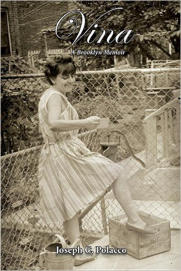
The Italian American Press specializes in
offering a selection of books primarily
written by authors of Italian heritage who
write about Italian American and Italian
culture, heritage, and history. Many of these
authors are independent publishers and
market their own books.
Reading stories of Italian American culture
and history will educate, inform, and
entertain people of all nationalities.
NOW AVAILABLE IN ITALIAN
Tra lacrime e risate - La vita di un emigrato italiano
. “I love this book because it brought back so many memories of my family and
of Calabria. But most of all because it is the story of emigration to America … a
story we too often forget to remember.”
~ Leon Panetta, Former Secretary, United States Department of Defense
Panetta Institute for Public Policy
Italian American Press
Founded in 2001 Italian and Italian American Authors
Italian and Italian American Books


ABOUT US CONTACT FOR AUTHORS ADVERTISERS



Featured Books
Vina, A Brooklyn Memoir
Joseph C. Polacco
Author Interview: Joseph C. Polacco

An Italian “I Remember Mama,” set in Brooklyn in the mid-
1900s. In a series of vignettes spanning over 50 years, Joseph
Polacco writes about “the abundant roads lit by Mom,” and
compares “her passing as the dimming of a light in so many
people’s lives.” The book includes photographs – some of the
“old neighborhood;” a guide to all the stops along the West
End Line, part of the NY City transit system that ran from
Coney Island north to Central Park (and also featured in the
car chase scene in The French Connection); and a glossary of
words (mostly Italian) commonly used at the time.
What inspired you to write your book?
Two
factors:
The
first
was
a
connection
to
the
Italian-American
culture
of
1950s
Brooklyn.
Living
in
the
Midwest
for
more
than
half
my
life
made
me
increasingly
appreciate
that
unique
culture.
As
a
typical
immigrant
grandson,
I
was
never
that
interested
in
life
in
the
old
country
and
the
factors
that
impelled
our
grandparents
to
seek
a
new
life
in
America.
So,
resurgent
cultural
pride
was
a
factor,
and
seeing
that
culture
dissipate
and
assimilate
sharpened
my
desire
to
document
some
of
it.
My
mother,
Vina,
was
a
direct
link to my immigrant grandparents, and I decided to pay more attention to her stories, recipes, and – yes – gossip.
The
second
and
most
important
factor
was
learning
of
Mom’s
dealing
with
a
recurrent
cancer,
after
seven
“cancer-free”
years.
As
her
illness
progressed,
I
made
at
least
14
monthly
trips
to
Brooklyn.
While
connecting
with
Mom,
I
reconnected
with
the
neighborhood
(Bensonhurst,
Bath
Beach,
Gravesend,
Bay
Ridge,
Dyker
Heights,
etc.),
and
with
neighbors
and
relatives
–
usually
the
same
thing
whether
or
not
we
were
blood-related.
The
Brooklyn
in
my
soul
was
revived,
as
were
its
dialect
and
expressions.
Mom
and
I
engaged
in
increasingly
frank
discussions.
I
realized
how
loved
and
how
unselfish
she
was.
Her
biggest
concern
was
not
for
her
dire
health
situation,
but
that
I
was
not
tending
to
my
job
or
to
my
wife
while
in
Brooklyn.
I
was
going
to
share
Vina’s
stories
with
the
many
who
loved
her,
but
decided
to
share
her
story
with
a
wider
audience.
The
book
is
not
just
an
ode
to
Mom,
but
to
strong
women
in
general.
What is the most important attribute of your book?
It
is
a
valentine
to
my
Mom,
mother
of
many
in
the
‘hood.
She
sacrificed
so
much
for
her
two
sons,
who
were
raised
in
the
back
of
our
stepfather’s
store
on
busy
86th
Street.
This
is
a
valentine
to
a
woman
whose
light
shone
on
many,
and
who
did
not
bemoan
her
sacrifices
or
openly
regret
lost
career
opportunities.
She
was
a
beacon
to
many,
and
through
this
book
I
try
to
reflect
some
of
her
light back on her.
Why should someone read it?
Virtually
all
of
us
are
immigrants.
We
are
stronger
Americans
by
recognizing
and
embracing
our
immigrant
backgrounds.
So,
the
book
is
not
only
a
journey
of
rediscovery
of
my
Italian
roots,
but
speaks
to
all
immigrants,
and
how
we
interacted.
The
first
chapter,
for
example,
speaks
to
Italian-Jewish
interactions
in
Bensonhurst.
Vina
was
wonderful
in
embracing
all
peoples,
and
that
love
was
returned; I wanted to document it.
In
the
book,
is
there
a
more
compelling
story
about
your
mother
–
one
that
has
a
more
personal
or
special
meaning
to
you?
When
I
was
with
Mom
at
Manhattan’s
South
Seaport,
circa
2007.
We
had
arrived
very
early
to
meet
and
spend
the
day
with
family
members.
Having
time
to
spare
we
had
a
nice
long
visit,
just
we
two.
Time
to
use
the
rest
room:
I
awaited
Mom
outside
a
long
wide
corridor
leading
from
the
ladies’
room.
After
some
time,
I
could
see
her
leaving,
accompanied
by
a
woman
of
color
–
a
woman
I
did
not
know.
They
were
chatting
like
old
friends,
and
before
they
got
to
me
the
lady
and
Mom
embraced
and
bade
farewell.
Naturally,
I
asked.
Seems
the
lady
took
her
young
son
into
the
ladies’
room
–
after
all,
who
would
leave
a
little
boy
alone
in
the
big
city?
The
lad
was
naturally
upset
and
uncomfortable.
Mom
jumped
to
his
rescue,
chatted
with
the
boy,
mentioned
her
own
two
boys,
etcetera.
His
mom
instinctively
trusted
my
Mom
and,
after
tending
to
her
business,
she
chatted
some
more
with
Mom,
a
conversation
that
continued until I saw them leaving.
What has been the feedback from those who have shared their stories about Vina and now see them in the book?
Several
told
me
they
got
teary-eyed
about
the
old
days
in
the
‘hood,
about
the
Brooklyn
in
their
hearts,
and
of
course
about
Mom;
and
this
includes
contributors
of
all
nationalities,
not
just
Italian-Americans.
One
woman
recently
told
me
she
had
to
wipe
away
tears, and that she will be giving a copy to her dad for Father’s Day.
In writing about your mother, what were some of the emotions you experienced?
Obviously,
I
felt
a
void,
if
that
can
be
called
an
emotion;
but
the
writing
and
fact
checking
with
Mom’s
network
helped
populate
that
void.
It
was
as
if
Mom
was
with
me,
and
I
included
a
poem
in
the
book
that
I
presented
at
a
celebration
of
her
life
at
the
Holy
Family
Home,
“You’re
still
with
me,
Ma.”
Mom’s
network
was
like
a
3D
mold
that
embodied
her.
I
miss
her
every
day,
especially
as
people
who
knew
her
slowly
leave
the
scene.
I
am
so
glad
to
have
been
able
to
“capture”
some
of
Mom
–
her
buddies,
her
extended
family,
and the Bensonhurst ‘hood.
How long did it take to write Vina, A Brooklyn Memoir?
Less
than
three
years.
In
a
way,
the
book
wrote
itself
because
I
had
testimonials
from
Mom’s
support
network.
Before
her
passing
I
was
the
“point
man”
for
that
network,
communicating
her
changing
medical
situation.
Upon
Mom’s
passing
I
canvassed
the
network
for
“Zany
Vina
Stories,”
which
I
soon
realized
portrayed
the
multiple
dimensions
of
Mom
–
her
spirit,
verve,
charity,
love,
talent
and,
yes, zaniness.
Mom
passed
in
late
February
2013,
and
by
December
2015
I
had
a
rough
draft.
I
pushed
too
hard
for
publication,
probably
a
result
of
my
career-long
dealing
with
the
“publish
or
perish”
imperative
as
an
academic
scientist.
After
a
couple
of
“false
starts”
a
copy
to
my
satisfaction
now
bears
a
2016
copyright.
Three
years
appears
to
be
lightning
fast
since
I
am
now
in
the
third
year
of
preparation
of
a
family
saga
novel,
starting
with
my
great
grandfather
as
a
street
urchin
in
Naples.
The
major
time
issue
now
is
finding
an
appropriate publisher.
Author Interview: Dr. Maria Lombardo
Dr. Maria Lombardo
A Camp Without Walls

From the Author
Being
temporary
camps
they
did
not
have
or
need
the
permanence
of
barbed
wire.
The
walls
were
horrific
German
Shepherd
dogs
that
encircled
the
camps.
The
dogs
were capable of increasing or decreasing the camp parameters at a whim.
My
father
and
254
other
inmates
were
told
by
the
Nazis
day
after
day
that
they
were
marked
targets.
Either
they
would
die
from
the
conditions
of
the
camp
or
they
would
be
blown
up.
The
Nazis
reminded
them
every
morning.
“You
will
die,
whether
we
win
or
lose the war, you will die.”
My
father
was
one
of
two
survivors
to
leave
that
camp
in
Yugoslavia.
This
book
speaks
of
a
man
who
did
not
physically
die
but
whose
soul
was
killed.
A
man
who
was
moved
from
the
camp,
but
the
camp
walls
were
never
removed
from
his
psychological
being
as
he
has
relived
the
enslavement
for
the
rest
of
this
life,
through
tormenting
nightmares during which he begged God for mercy and relief from pain.”
What inspired you to write your book?
Growing
up
listening
to
a
father
who
had
shrilling
haunting
nightmares
that
would
cause
him
to
shake
uncontrollably
and
scream
in
his
sleep,
I
wanted
to
know
what
happened
to
him.
My
enlightenment
came
when
a
Jewish
survivor
told
me
the
story
of
this
family’s
rescue
by
the
Italians
in
Yugoslavia
during
World
War
II.
Suddenly,
the
connection
–
my
father
had
been
imprisoned
in
Yugoslavia
for
his
part
as
an
International
Resistance
fighter
resisting
the
Nazi's
and
their
atrocities.
Somehow
these
stories
needed
to
be
told,
thus
my
research
into
the
Italian’s
role
in
the
Holocaust.
By
writing
proposals
to
the
National
Endowment
for
the
Humanities
and
with
matching
funds
from
the
National
Italian
American
Foundation,
I
was
able
to
fund
and
conduct
close
to
50
conferences
nationally.
I
documented
my
journey,
my
father’s
impact,
and
the
history of Italian citizens rescuing 80 percent of the Jews in Italy and Italian occupied territories during World War II.
What is the most important attribute of your book?
The
most
important
attribute
of
the
book
is
to
pay
tribute
to
rescuers
and
survivors
of
the
Holocaust
in
Italy
and
Italian
occupied
territories.
By
writing
the
book
I
learned
how
my
father’s
humanitarianism
in
saving
his
fellow
man
provided
him
faith
and
endurance,
as
one
of
the
two
men
to
survive
a
Nazi
slave
labor
camp.
Beyond
social
history,
I
wanted
to
relate
my father’s impact on our family for future generations.
Why should someone read it?
People
should
read
this
book
as
an
important
resource
on
Italy’s
role
during
the
Holocaust.
One
learns
through
my
father’s
story
what
makes
the
Italians
so
different
in
wanting
to
help
the
Jews
during
Nazi
oppression.
One
gains
an
understanding
that
the
Nazi’s
did
not
impact
their
contemporaries
but
they
impacted
generations
to
come.
I
divided
the
book into my family’s personal story, history of Italy during World War II, and resources on the period.
Where can
A Camp Without Walls
be purchased?
The hardcover book is available by contacting me directly at
lombardoma@aol.com
.
AUTHOR WEBSITE

